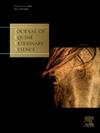Testicular hormones production and the gene expression of their receptors in the testicles of stallions subjected to scrotal heat stress and treated with pentoxifylline
IF 1.3
3区 农林科学
Q2 VETERINARY SCIENCES
引用次数: 0
Abstract
Depending on the duration and intensity of scrotal heat stress, the impact on different cells of the testicular parenchyma varies in severity, initially compromising spermatogenesis and, in more severe cases, impairing hormonal production. Pentoxifylline has been shown to reduce histological damage from testicular degeneration in horses, but its impact on testicular hormonal production after heat stress is still unknown. This study evaluated the effects of heat stress and pentoxifylline treatment on serum concentrations of testosterone, estrone sulfate, and anti-Müllerian hormone (AMH), as well as on the gene expression of their receptors in testicular biopsies of stallions subjected to scrotal heat stress. A total of 14 stallions were divided into three groups: Control (CRL, n=4), Testicular Degeneration (DEG, n=5), and Testicular Degeneration Treated with Pentoxifylline (DEG+PTX, n=5). Testicular degeneration was induced by scrotal insulation using a thermal bag filled with air at 50°C for 1 hour, twice a day (early morning and late afternoon), over two consecutive days (D-1 and D0). From the following day (D1), oral pentoxifylline (17 mg/kg) was administered every 12 hours for 30 days. Blood samples were collected by external jugular venipuncture once a week for eight consecutive weeks. Serum concentrations of testosterone, AMH, and estrone sulfate were determined by ELISA. On days 30 (D30) and 60 (D60), testicular biopsies were taken and snap-frozen for later evaluation by RT-qPCR. The genes evaluated were AR, ESR1, ESR2, and AMH. Normally distributed data were analyzed using a mixed-model ANOVA, and non-normally distributed data were analyzed using the Wilcoxon test, using JMP 12.0 software (SAS Institute, Cary, NC, US). No significant differences were observed between the experimental groups in serum concentrations of testosterone, estrone sulfate, and AMH over the 60-day evaluation period, and all values were consistent with reference values for healthy animals. However, after 60 days of thermal injury, there was a significant increase in AMH gene expression in the pentoxifylline-treated group compared to the control group (P<0.05). No other differences were observed between groups for the other genes evaluated. In conclusion, the heat stress induced in this study did not impact gonadal hormone production or the gene expression of hormonal receptors in the testes. Furthermore, pentoxifylline appears to exert an effect on the upregulation of the AMH gene after 60 days of treatment.
求助全文
约1分钟内获得全文
求助全文
来源期刊

Journal of Equine Veterinary Science
农林科学-兽医学
CiteScore
2.70
自引率
7.70%
发文量
249
审稿时长
77 days
期刊介绍:
Journal of Equine Veterinary Science (JEVS) is an international publication designed for the practicing equine veterinarian, equine researcher, and other equine health care specialist. Published monthly, each issue of JEVS includes original research, reviews, case reports, short communications, and clinical techniques from leaders in the equine veterinary field, covering such topics as laminitis, reproduction, infectious disease, parasitology, behavior, podology, internal medicine, surgery and nutrition.
 求助内容:
求助内容: 应助结果提醒方式:
应助结果提醒方式:


